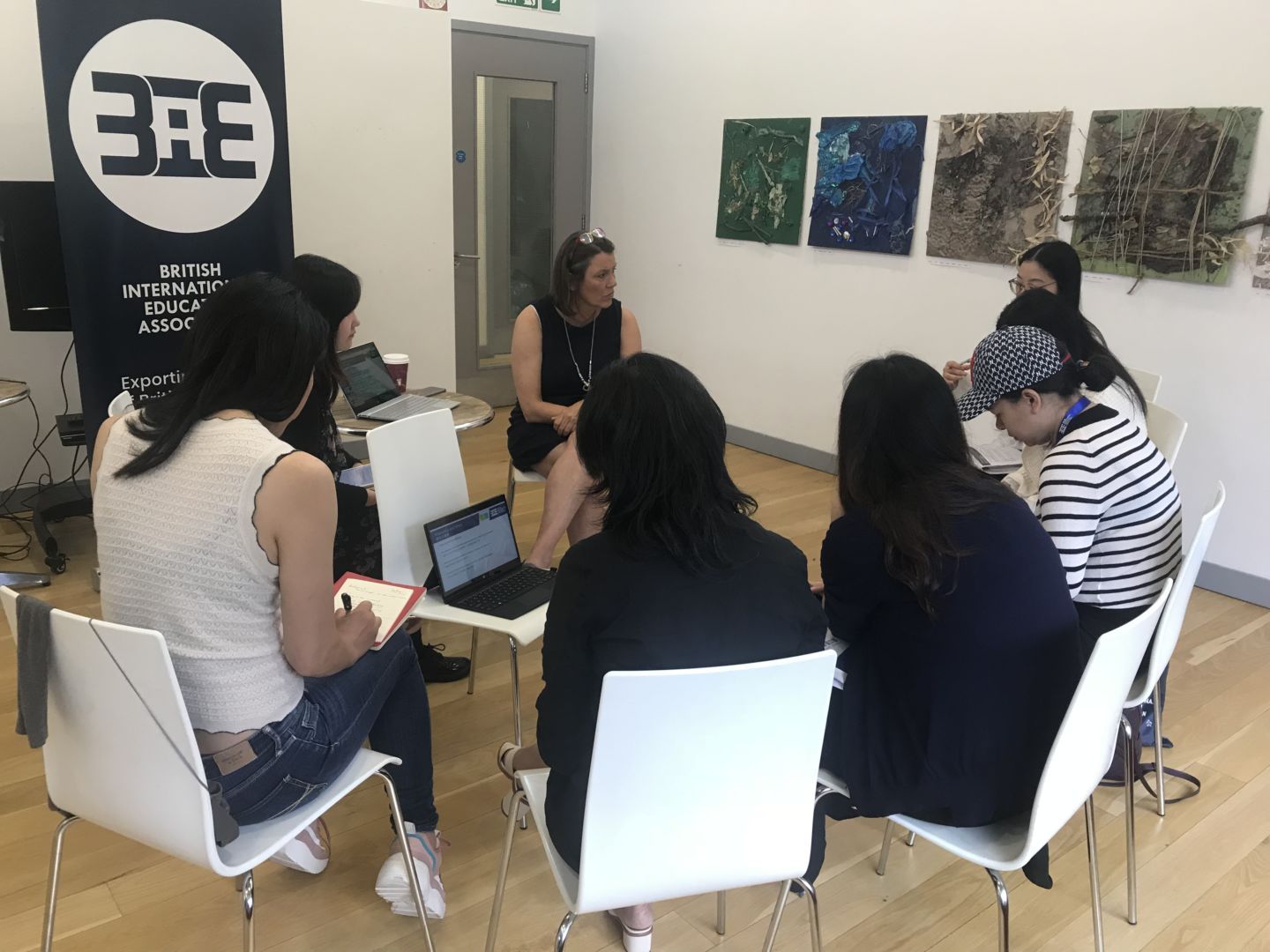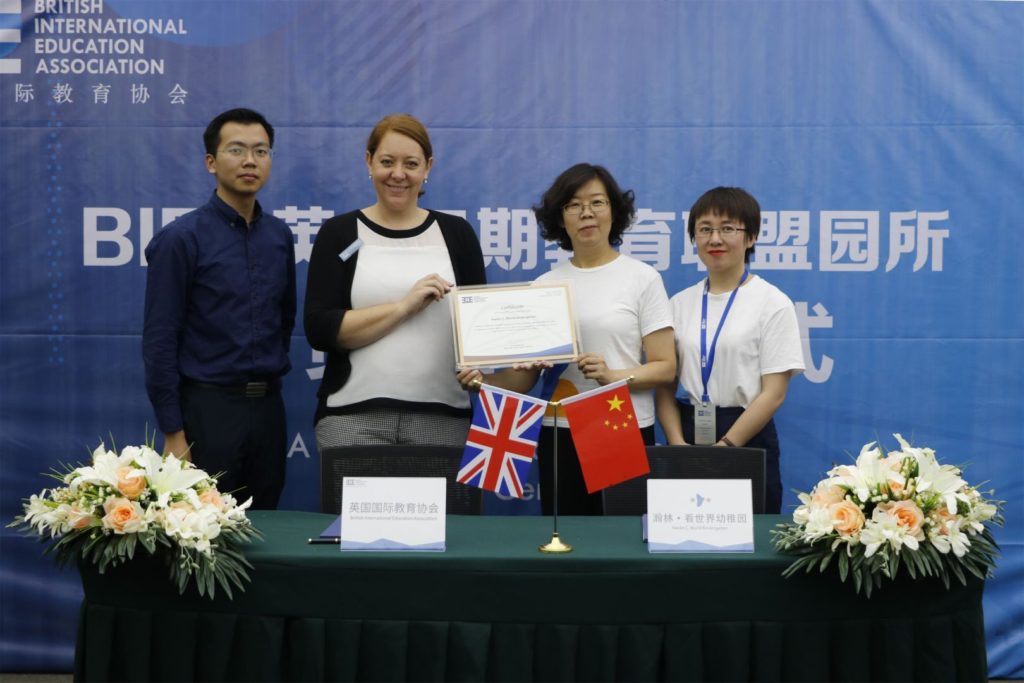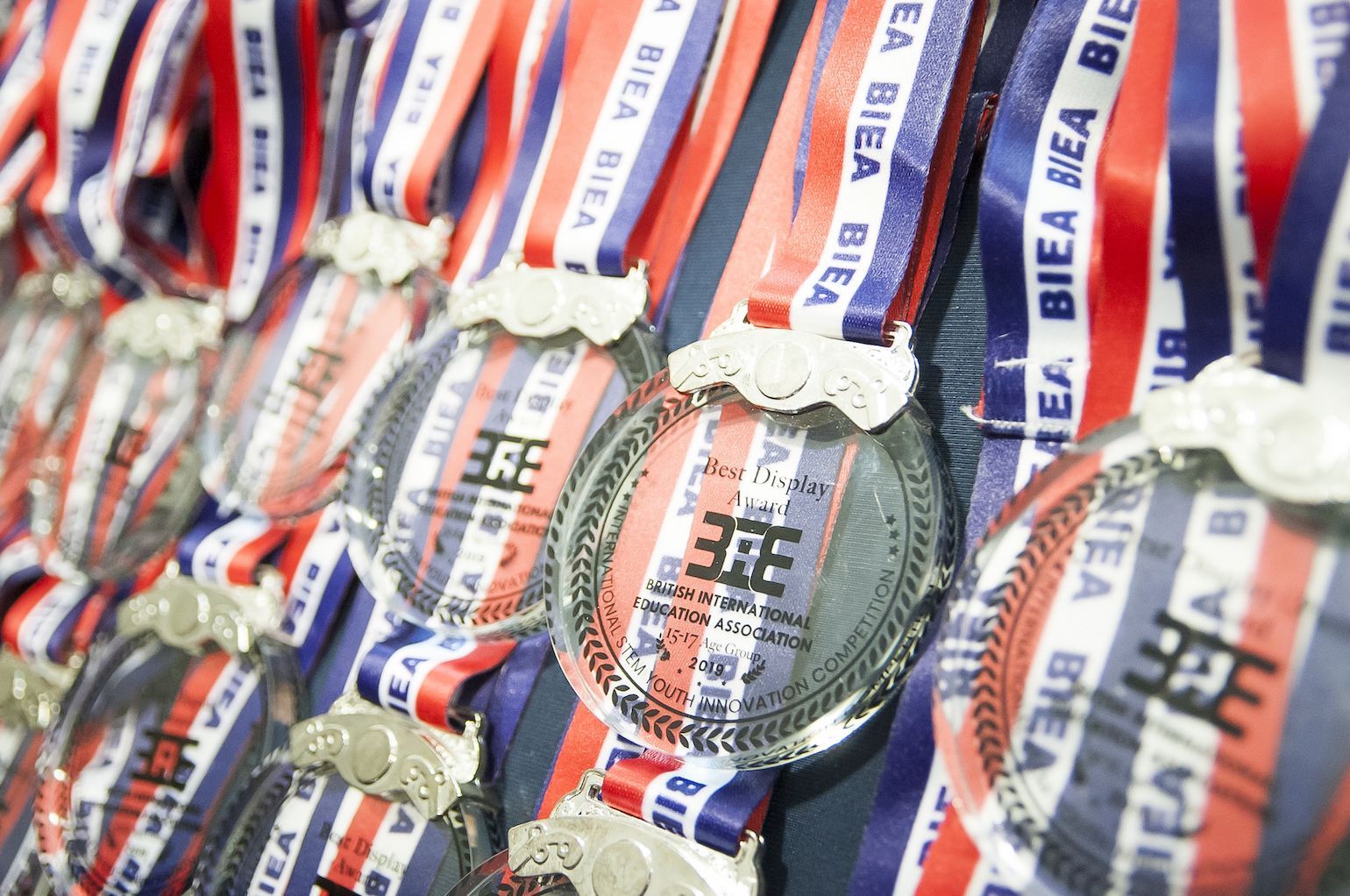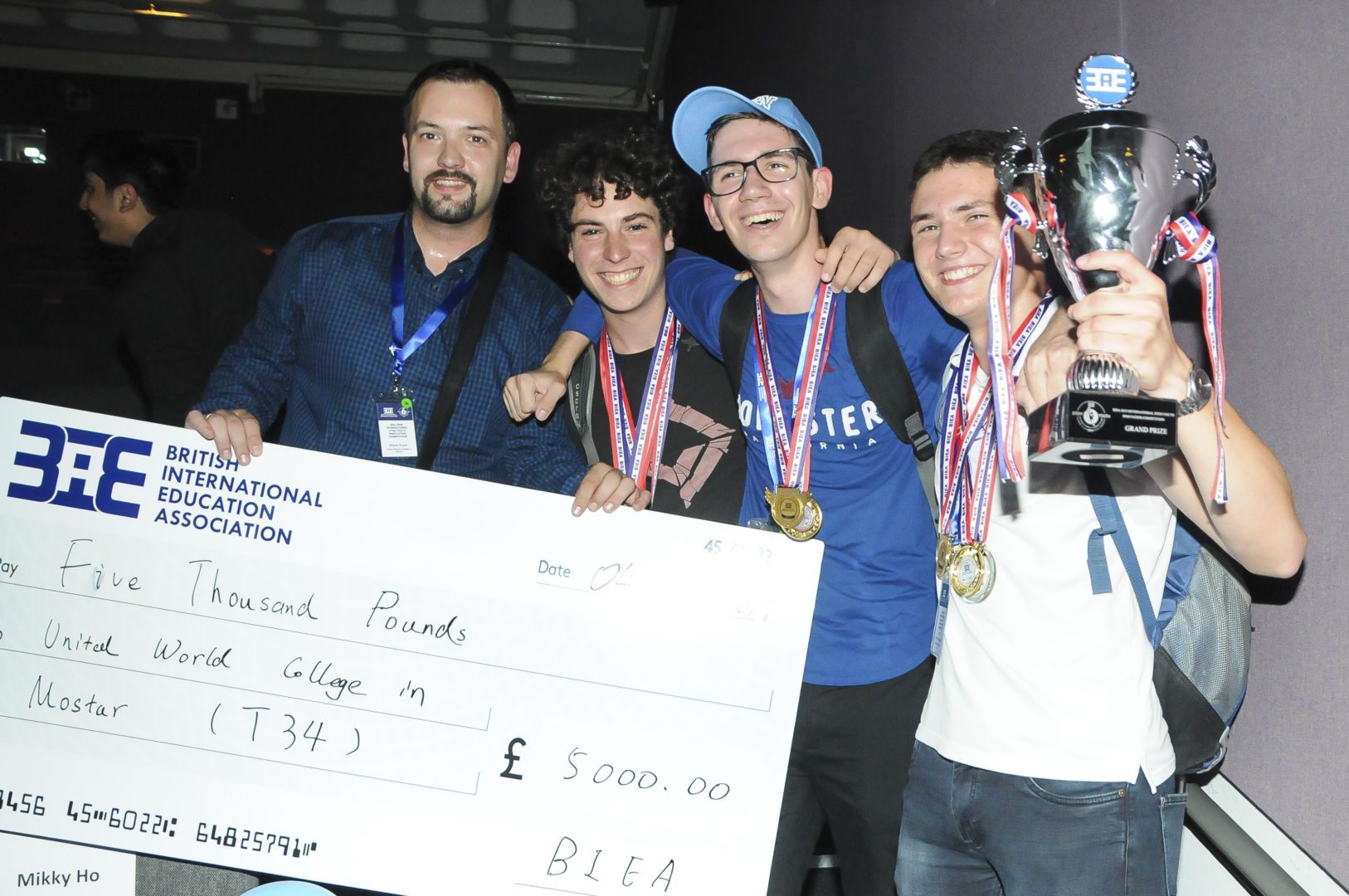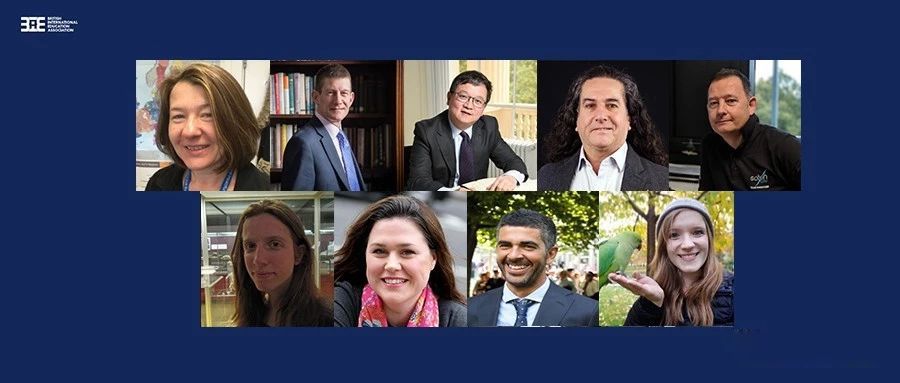Immersive experience of Forest education: Enabling the teachers to explore nature like a child
On the second training day of the BIEA’s UK summer study tour, the participants were taken on an immersive forest education curriculum experience. Under the leadership of Ingrid Chen, a forest teaching expert with 5 years’ worth of experience in forest schooling, the participants were given an opportunity to explore, observe, and discover nature. Ingrid Chen mentioned “we want to involve children in forest schools, so teachers must first learn to enjoy nature and care for the environment”. In today's forest school experience, fellow teachers and Ingrid Chen shared the basic activities with taken in forest schools through demonstration in different locations such as parks and nature reserves, allowing the development of rule awareness and risk assessment of outdoor activities within the participants. The teachers were truly aware of the joys in exploring nature and the teaching philosophy centred around children.
The participants had a simulated forest education lesson in Ion Square Forest School area:
- Risk assessment: Adults should first look at the environment and try to remove or mark potential risk factors such as glass shards and animal waste. Teachers should then use flags to define and distinguish safety boundaries where children could easily be observed.
- Teaching rules: No pick, no lick - Don't let children pick up foreign objects, and especially don't let them put foreign objects in their mouth.
- One two three, base camping – When 123 is said out loud the children should return to base camp.
Forest education activities:
- Treasure hunting
Ask the children to explore the environment freely and find treasures that they like, such as animal feathers, dead branches, leaves and so on. This is usually the first activity partaken in forest education, which allows children to get acquainted with the environment and develop a deep understanding of the rules. Based on the child's ability and needs, it can be extended to create routines and to play games with other children, reinforcing the character within the child.
- Mud kitchen

Firstly, locate a suitable soil area and then provide the children with some containers and water buckets, allowing them to play and make a mess. When the teacher observes the children playing, they will find that some children like to make mud cakes, some children may like to use wooden sticks to make a mark in the mud, or some children like to look for small bugs in the wet mud and so on. According to the children's interests and needs, the teacher will provide corresponding materials in the following forest activities as further support for the children's exploration journey, which is in line with the concepts advocated within the EYFS framework - continuous provision:
a. Bug hunting
The child will search for an insect in the mud and place it into a container. The lid of the container is designed to resemble a magnifying glass, this allows the child to observe the characteristics of the insect and learn basic entomology. The study tour participants participated within the activity and collected the insects they discovered and discussed their findings with each other.
b. Cloud marking
Ingrid demonstrated the activity of marking clouds, she laid down on the grass and observed the shape of the clouds in the sky. Ingrid then proceeded to draw the clouds on a piece of paper using a pencil. Ingrid shared with the participants that the forest school instruction manual was written by her, including; pre-preparation for forest education courses, children's dress code, risk assessment form, forest school activity plan, emergency plan, and forest school information for parents. Ingrid Chen mentioned that by nature the forest school initiative promotes conversation and the important roles humans play in careful balance of ecology.
Here were some frequently asked questions by the participants:
Q: What if a child uses the tools given as a weapon to fight other students during outdoor activities?
A: Firstly, teacher should introduce the correct usage of the tools and the precautions the children must follow if they wish to use the tools. In the process of children using tools, teachers should promptly encourage and praise the positive behaviour of children to reduce the occurrence of some negative behavioural patterns that might occur. Although sometimes the danger occurs, the teacher role is to always observe the children and prevent conflict before it happens. The teacher might say “stop” but the they should avoid using the negative expression to increase learning through negative reinforcement.
Q: Whilst searching for insects, the teacher and the children exchanged discussions about finding insects. What if an insect was found that the teacher was unaware of?
A: This happens very often. We will usually discuss with the children "what are you looking for? Where did you find it? What do you think it looks like?”. Teachers, like children, are all explorers who are curious about nature. Our interest in nature does not mean that we must become knowledgeable entomologists or scientists. The most important thing is the process of exploration and inspiring children's curiosity about nature. How the child is really interested in an insect will allow the child to develop their own understanding of it, but they may also ask the teacher questions. Therefore, it would be advantageous to the teacher if they prepared some books about insects and plants prior, but these should only be for the older children or children who have a particularly strong desire for knowledge.
BIEA UK summer study tour Day 1: Early Years Foundation Stage (EYFS) early years education practice
On the 12th of August 2019 BIEA's summer UK study tour finally begun. Eleven teachers from China arrived in London. The participants were greeted by Claire Berridge, a lecturer from Bryanston Nursery, who has gained more than 20 years’ of experience in early years education as well as possessing a Bachelor of Arts degree in IOE Education. Claire Berridge shared the fundamentals and her experiences working within early years education (0-3 years old) and used Bryanston Nursery as an example of how early years education is handled properly in the UK. Ms. Mita Pandy, Archway Nursery Director led the participants to visit the entire nursery. The participants interacted with Claire who enthusiastically and actively discussed with Mita how EYFS supports the development of early years education.
- Core theory - child centred learning
Claire emphasised that the most important thing in early years education is to know that the child is the core focus. Each child should be treated as a separate and special individual. Each week, 4-5 children will be selected as the focus. The teacher will carefully observe them and write detailed observational reports, including details of daily life and even the child’s eating routines. The most important thing about the observational report is to allow the teacher to learn more about the child. This includes the child's interest, which the teachers would use to build an appropriate teaching schedule full of activities the child can learn the most from. A strict rotary is followed to allow every child to be at the focus of the observation, which provides opportunities for all the children to grow into independent, confident and successful academic students. The participants stated that the core of China's early years education is also child centred, and that they share common ideas and philosophies within their respective early year’s education fields.
On the other hand, the child centred learning also relies on many positive daily interactions with qualified, caring and attentive early years education teachers. The teacher is not only an observer, but also an examiner. In the process of interacting with the child, the teacher understands and discovers the child's abilities, interest and emotions. It is difficult to grasp the skills required to deeply understand a child, but it all starts with being an attentive listener and having a keen eye to observe what most would simply neglect. Claire used a good example to demonstrate how one can learn from a child’s behaviour. When a child is playing with a car, the teacher might ask questions about the child's mathematical ability, such as "how many cars do you have?". The child might refuse to answer because they know that the teacher can count and is therefore testing them. But when the teacher asks, "could you give me an X number of cars?", the child may not only fulfil their request, but also share their toys with the teacher. This is a positive interaction that reinforces the student teacher relationship mentioned in EYFS.
- Learning through playing
Claire mentioned that there is no teaching plan in their nursery, because the children are learning during play sessions. She believes that every play session is an exploration of oneself. What the child learns in the process of playing is creativity, critical thinking, problem solving skills, perseverance, and interpersonal skills. These are the learning goals emphasised in EYFS which would help to refine the child into become a good citizen within society when they grow up. Children's learning is critical, and children aged between 0-3 learn most about the delicate societal norms we face in everyday life when they play with other children. When the child reaches 5-6 years old, they gain the cognitive ability to learn about words and numbers, and thus, the teaching style of the teacher must adapt too. The participants were made aware of the significance of play.
- Key person system
For the care of children aged 0-3 years old, the “key person system” is a very important individual to them. Claire said that in her nursery, each child has a fixed key person for intimate care and family communication. The participants felt very helpful when Claire shared how her nursery implemented the “key person system”. The intimate role of the key person mainly includes changing diapers and napping them, and these intimate behavioural patterns allows the key person to quickly establish an attachment relationship with the child allowing the child to build a sense of security within the nursery. It is also important to establish contact with the family. The key person is the first contact for the parents and is the one within the nursery that understands the child the most. After the parents understand the child's situation, the child's care in the nursery is consistent with the parents’ care of the child at home, this includes, living habits, toys and even food. Parents need to complete the EYFS assessment report every three months, whilst the teachers complete the observational report regularly, allowing the nursery to document the child’s progress and highlight areas that need more focus within the child’s care.
- Archway visit
After a short break, the participants visited the Archway Nursery under the leadership of Mita. The participants expressed their great interest. There is an outdoor activity area, which is like a small forest. In addition to the garden, where children can pick vegetables for salads, there is also a small farm in which chickens hatch eggs. The location was deliberately set up as a “risky environment” for the children. It did this through including big rocks, pools and even poisonous plants. The teachers hoped that this real environment can allow children to build a sense of danger to increase their situational awareness skills. This is one of the concepts under the EYFS framework.
Hanlin C. World Kindergarten becomes the first member of BIEA E-League in the Hebei region
We are proud to introduce Hanlin C.World Kindergarten into the BIEA family. The kindergarten, situated in Hebei region, has become the first kindergarten in its region to become a member of BIEA E-League. The E-League aims to provide the best of British early years education (EYFS – Early Years Foundation Stage) whilst also adapting the British education system to fit the local culture. This allows young academics to experience a prestigious internationally recognised education without losing touch of their wonderful culture.
Hanlin C.World Kindergarten is an international nursery located in Shijiazhuang high-tech zone. The 24,000 square metered institution puts the natural ecology of the land at the forefront. This allows the young academics to grow up conscience of the Earth around them so that in their later years they can join the fight for conservation. The institution also has a construction area of 13,000 square meters. As the nursery is an extension of the Hanlin Education Group it adheres to the philosophy of the “happiness education” aim, which has continued to flourish since it was introduced 18 years ago.
The natural ecology of the land in combination with the “happiness education” philosophy has resulted in the nursery aiming to create a “fairy tale kingdom”. Hanlin C.World does this by incorporating the near-by forests in tangent with castles to allow the young academics to free their mind and let their creativity be at the forefront. As a result of Hanlin C.World joining the BIEA E-League the nursery has actively participated in the UK CPD training course organised by BIEA. With the integration of EYFS into China’s rich and traditional culture it will allow the children to boost their inter-personal capabilities whilst also having the adverse effect of bringing the children closer to nature by building on Hanlin C.World’s ecology focus.
Through their involvement in the E-League Hanlin C.World’s 39 teachers have received training in Guangzhou, which has allowed them to actively interact with EYFS experts from the UK. The training course has promoted Hanlin C.World’s teachers to established a systematic understanding of the UK EYFS education framework, which helps to develop children to become more independent, confident, curious, comprehensive and love learning. This has given Hanlin C.World’s teachers the opportunity to incorporate the depth of knowledge contained in British education into their curriculums and teaching styles to promote a better standard of teaching.
To conclude, Hanlin C.World Kindergarten’s focus on an ecological education not only includes a wide range of outdoor activities (football fields, golf courses, etc.), but also a very warm and scientific indoor environment (home-style classrooms, independent activity rooms, chlorine-free indoor swimming pool, etc). The E-League course will allow teachers to focus on the core values of EYFS; a safe child-centred education, a deep and rich education programme that has been refined to perfection over centuries, and a rigorous training course to allow Hanlin C.World to make the most of their first-class facilities in an effective but safe way.
BIEA E-League UK EYFS teacher vocational training in Guangzhou
The latest British EYFS Teacher Vocational Training course of the BIEA E-League was held in Guangzhou between the 26th and the 28th of July. British EYFS expert Angela Fedi led early years teachers from across the country in a study of EYFS basic knowledge and understanding.
The teachers were enthusiastic concerning the EYFS teaching and paid close attention to the lecture. Ms Fedi illustrated means by which teachers can more effectively interact with children using EYFS procedure and led discussions regarding this and other classroom issues.
Teachers who are conducting group discussions in class
Angela Fedi, who has had nearly twenty years of experience in nursery education, gave an example of positive interaction with a class. “In nurseries in the UK, and when children are playing their own games, children may compete for a toy or space. The teacher will usually stand by and watch the children deal with the matter amicably. Once a child’s argument is becoming out of control the teacher will intervene but if the children are discussing the matter in a positive manner the teacher will withdraw and watch the children resolve the matter themselves.”
Angela went on to further illustrate EYFS teaching practice using the ideas expressed in the publication “Development is Important” regarding the seven major areas which increased enthusiasm within the classroom and enabling an understanding and creating a favourable environment for EYFS education to flourish. The teachers formed seven groups, each one representing an EYFS learning field, and discussed their various relevance to creating good conditions for EYFS practice to operate as mentioned in “Development is Important”.
BIEA E-League signing ceremony with nursery members
In addition, during the break time, the organiser BIEA E-League also held an on-site signing ceremony with Hanlin C.World Kindergarten, Waddington International Kindergarten, Deer Idol and Inbay Starson Nature Education Garden.
Lecturer Angela Fedi
Ms Fedi believes that Chinese teachers have a great enthusiasm and ability to understand and practice advanced UK early years education methods. She was impressed by the quality of the class.
The marketing department of the BIEA E-League carried out a training evaluating afterwards and found a unanimous satisfaction amongst those who had attended. The BIEA E-League UK EYFS teacher vocational training in Guangzhou was successfully concluded. The next EYFS training will start in Beijing in August.
BIEA 2019 International STEM Youth Innovation Competition was successfully concluded and animal protection proved to be a popular theme
The BIEA 2019 International STEM Youth Innovation Competition ended at the RAF museum with the finals being held on the 4th of July. Twenty-eight finalists from the UK, USA, India, Bosnia and Herzegovina, Poland and others competed. Embassy officials, STEM experts, educational and industrial representatives witnessed the judging and participated in the awards ceremony.
Professor Claudio Sillero, Chief Scientist of The Born Free Foundation said “This STEM competition with the theme “Fighting Extinction via Drone Technology” has not only won the praise of the guests, teachers and students, but we are even more pleased that the competition has also brought a very positive impact on the global animal protection initiative, encouraging society to use advanced science and technology to protect animals and the earth.”

Professor Claudio (third from left) served as a judge in the evaluation session
Wei Lai from Central St Martins College, who participated in the design of the flying venue at the finals, said “I have participated in many design projects but never in a project like this. It’s fascinating. The biggest difficulty was simulating reality and abiding by the strict material requirements. With the theme being animal protection all material used had to be environmentally friendly. Forest, ocean and desert had to be simulated. Much of the material used was from recycled everyday objects. We also managed to get The National Theatre to rent us life-sized animal models to keep costs down.
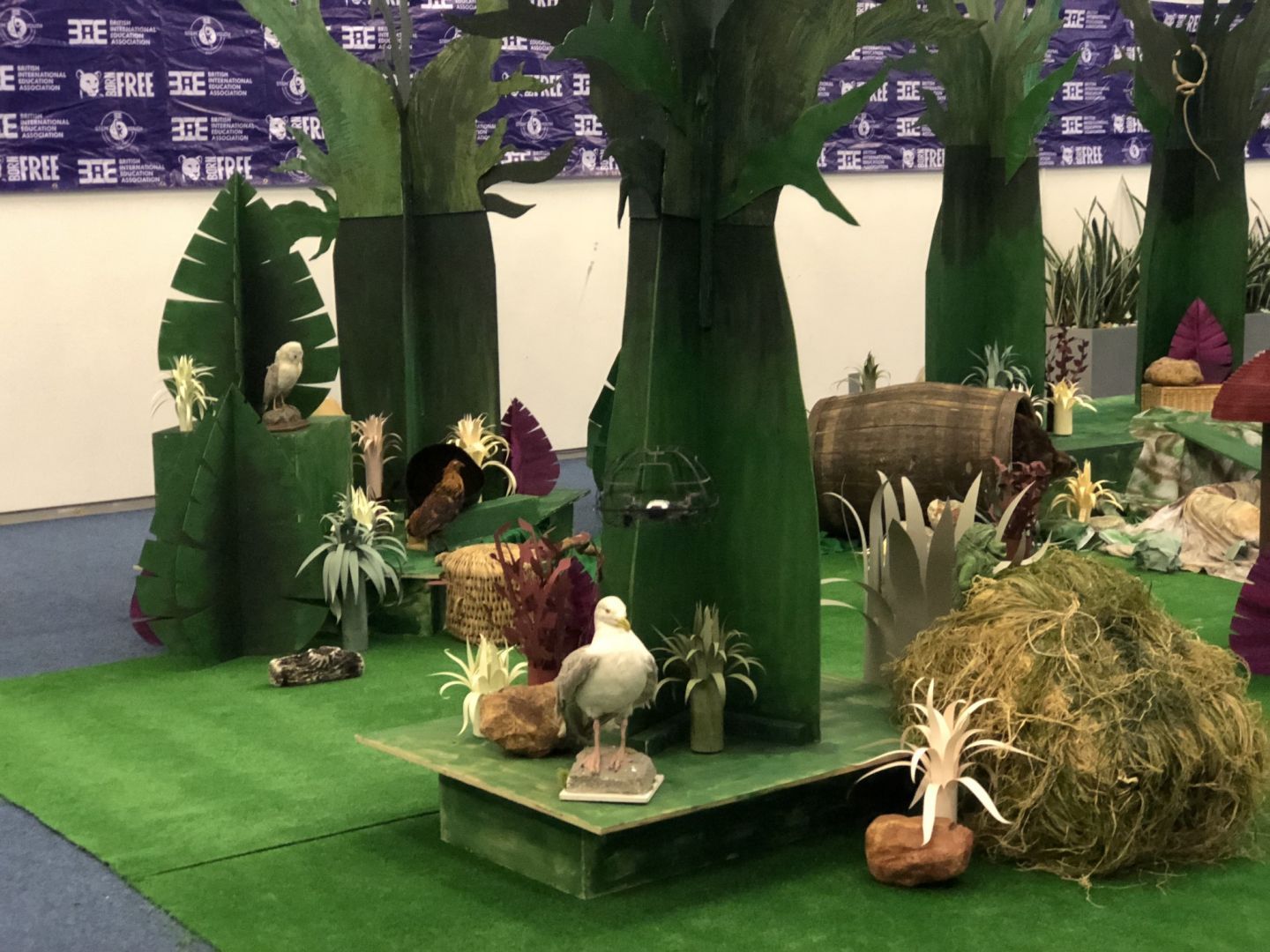
Flying hall scene
It took a year from the competition initiation to the finals in July. All the effort and hard work made the BIEA Youth Innovation Competition a great success in practice and in significance. Whilst emphasising the importance of animal preservation the theme of the competition also signified the potential of technological innovation in helping to achieve such a goal. Schools and children from around the world entered with enthusiasm for utilising STEM and drone technology to save animal species.
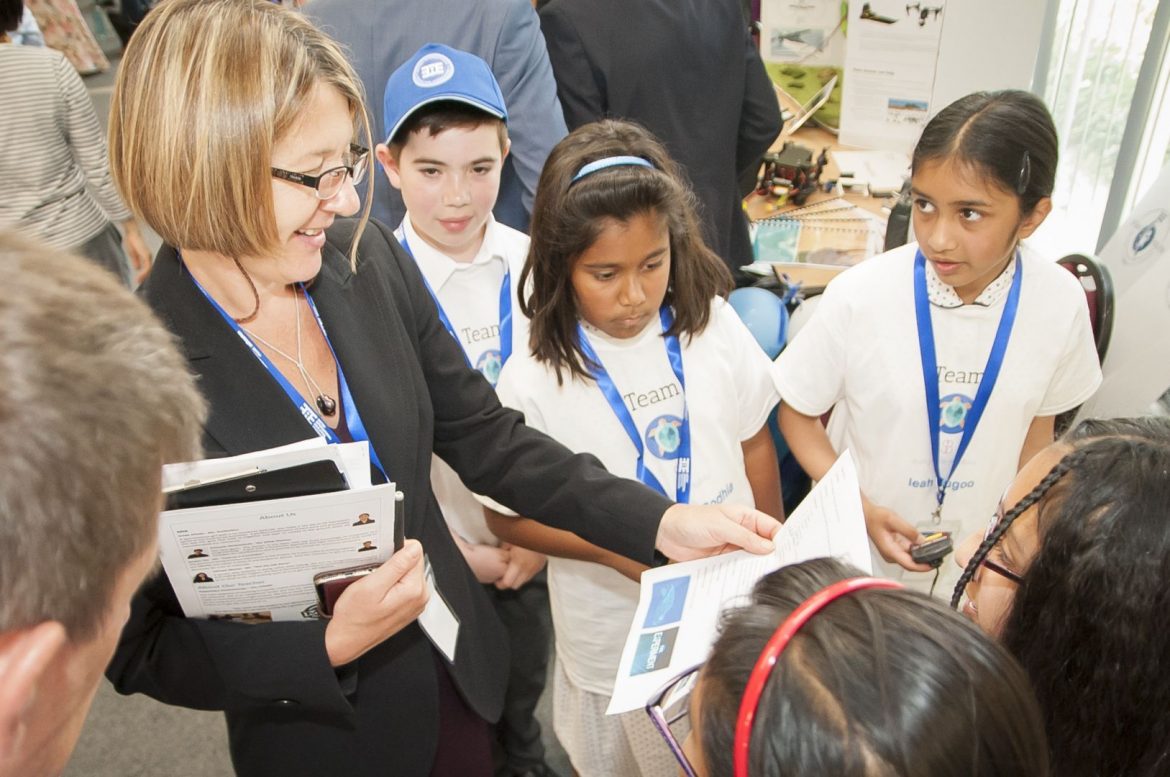
Dr. Holmes served as a judge at the presentations
Winner of The National Science Teaching Award and chief designer of the competition Dr Alex Holmes said “In this competition the number of rare animals studied is exciting. Many animals selected are related to the regions where the school teams come from which enables us to understand a lot about the animals while also learning about STEM. For example, Coleraine Grammar School has studied the Basking Shark which visits Irish waters but is rarely seen. A team from Sheffield Park Academy chose to help protect the Tasmanian Devil, other teams chose the scorpion, the Red Wolf, Markhors or wild goats, Snow leopards and Red Pandas. The enthusiasm with which the creative animal research and subsequent drone design was carried out deeply touched the hearts of the judges. Species preservation has never been as important as it is at present and it is gratifying that younger generations are confronting this now. All who participated in the competition have made a contribution to working towards confronting this crisis.”

Screenshots of some media reports locally and abroad
The International STEM Youth Innovation Competition successfully stimulated an interest and enthusiasm amongst the young in using modern technology to help in animal and environmental preservation.

Adrian attended the celebration cruise dinner
The STEM consultant of the British Council, Adrian Fenton, said of the competition, “This competition brings together teenagers from all over the world to provide them with opportunities to learn STEM skills and exchange ideas, providing them with a platform to benefit humanity and protect animals using technology. I am full of expectations for next year’s competition, which will be more and more exciting!”
Bosnia and Herzegovina's UWCIM team won the BIEA 2019 International STEM Youth Innovation Competition
On the 4th of July, the six-month long BIEA 2019 International STEM Youth Innovation Competition, held at the London Royal Air Force Museum, came to a close. The intense competition included display demonstration, evaluation and flying. The winners of the grand prize and the champion of the 15-17-year age group were the UWCIM team from Bosnia and Herzegovina.
Members of the UWCIM team explained that due to Bosnia and Herzegovina’s previous conflicts, the country is neither developed or rich in educational resources, however, this failed to affect the children’s curiosity and pursuit of knowledge in science and innovation. The UWCIM team comes from the United World College in Mostar, that like other UWC schools around the world, aims to promote world peace and sustainable development by uniting different countries, people and culture through education. The students of the champion team UWCIM are technological innovation enthusiasts, who not only focus of pursuing STEM subjects, but also word hard to find ways to put their creative ideas into practice.

Team members from UWCIM exchanging ideas in the preliminary session of the competition
The STEM education in schools’ help develop students’ passion for science and innovation, and the traumatizing history of Bosnia and Herzegovina has further helped develop this devout respect nature and life. While most of the teams focused their “fighting extinction via drone technology” project on counter-hunting, the UWCIM team added a novel focus on how to solve the problem of Egyptian vultures that feed on animal carcasses, as this poses a threat to ecosystems as well as spreading diseases. In the report and video presentations, the team not only showed a solid technical ability, but also outlined how they would use drones to solve this big issue. In particular, the group explained how the war in Bosnia and Herzegonia had left 80,000 bombs in the mountains that in turn threatening the Egyptian vultures home. It poses great challenges to experts and scholars who protect and study them, and it was easy to see that the UWCIM team truly understands the essence of science and innovation as well as the spirit of humanism.

Team members from the UWCIM team
Despite their captivating performance in the preliminary round, their hardest challenge was yet to come. Because the school had limited funds, it was next to impossible to provide financial help to the UWCIM team in order to participate in the London finals. The cost of the trip to London soon became their biggest problem. The team began writing letters to the school outlining their hard work through reports and videos. Eventually they contacted the sponsors of the school and finally the problem of boarding and lodging in the UK was solved and the school decided to provide transportation subsidy to the team. Unfortunately, this wasn’t the team’s final hurdle. The visa application of the team member Israa Draz was rejected, and the visas of the other three members were delayed. Two weeks before departure, just when everyone thought they would miss the final, two members received their visa. The team was overjoyed and the two students carried the team’s enthusiasm to London.

UWCIM team in the evaluation session on the final day
The UWCIM team was just one of the 28 finalists at the Royal Air Force Museum. The team responded well in all aspects of the competition. Under the precise command of pilot Aris Karamustafic, alongside two members of David Christian Busley, David successfully captured 11 valuable animal photos using superb flying skills, achieving zero collision, zero runaway and not to mention a safe landing. In the end, the UWCIM won the championship of the 15-17 age group and won the crown of the highest award in the competition, thus winning the overall prize of 5,000 pounds in one fell swoop!
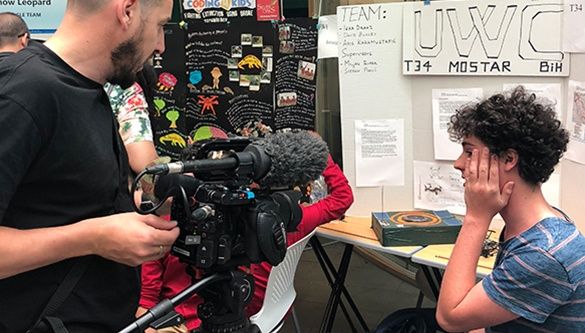
UWCIM team in the technological achievement showcase prior to the final
Team member Aris Karamustafic had a brief conversation with BIEA STEM Chairman David Hanson after the awards ceremony. He excitedly said to David: "I am from a small country, you may not be able to imagine, before coming to London, I have never been to the plane, have not been to a cruise ship, or even seen the subway. I have never expected to win the game with my teammates, because it is not easy for us to compete with other teams. The fact is that we won the championship. This feeling is really amazing and wonderful! Thank you very much for the BIEA STEM Competition. Thank you for giving us such great encouragement and courage. It is BIEA that makes us believe that science and education have no national boundaries. Today is definitely the best day of my life!"

UWCIM team in the flying session
David also told the media after the competition that this year's BIEA International STEM Youth Innovation Competition was not only a creative transformation competition for drones to save endangered animals, but also a brilliant showcase of the students' performance in the field of science and technology. BIEA appreciates the sheer enthusiasm of the students in these projects, and is eager to push the competition to an even further international level. BIEA not only promotes the exchange of international science and education, but also provides students with a chance to realise their dreams!
Let us cheer for this champion team, and for this unique international youth science and technology event, and look forward to next year's competition!
Green Rye Nursery, the first BIEA E-League member nursery in Guizhou
In Guanshanhu district, Guiyang city, Guizhou province, there is a nursery with British Early Years Foundation Stage (EYFS) as the core. As the member of the British International Education Association (BIEA) Early Years League (E-League) in Guizhou, this nursery not only pursues the establishment of authentic British EYFS nursery, but also has a high pursuit of teaching quality.
Since joining the BIEA E-League in November 2018, it has not missed any EYFS themed training course sponsored by the E-League. After three periods of professional and systematic training, the backbone teachers of the nursery have mastered the core content of British EYFS teaching. The school has identified three basic areas in which the EYFS supports children's learning and development (communication and language development; physical development; personal, social and emotional development) and four specific areas (literacy; mathematics; know the world; the content of art and design expression is integrated into the curriculum design of the nursery and integrated into the one-day process of the nursery. It has become one of the teaching features of the nursery to insist on the child as the centre and take games as the basic activity to promote children's learning and development.
In addition, Green Rye Nursery also introduces professional children swimming courses and forest education. As Guizhou's first nursery offering forest education, in order to provide more professional and conforms to the children's physical and mental development of outdoor course, the nursery took an active part in training and activities organised by BIEA E-League, for example, studies group activities, director and backbone teachers from many well-known nurseries visited London after the characteristics of running a nursery, to return to studies of insight into the nursery design, which contains the natural ecological elements as main content to plan outdoor activities. In the nearly 11,000 square meters of outdoor space in the Green Rye nursery, there are not only large multi-functional wooden climbing frame, swing, slide, etc., but also towering trees and lush grass. The wide natural space provides great support and positive influence to cultivate children's independent character and exploration spirit.
Personality independence, initiative, theoretical innovation are the goals of Green Rye Nursery education. The nursery offers learning and development education through providing children with time and space, and growing support based on the characteristics of the child's own development, let every child can study in the environment of freedom, love with deep satisfaction and self-realisation.
In the future, Green Rye Nursery will continue to be supported by the E-League with great wealth of professional teaching resources support, which will be the essence of the British education to be instilled effectively into the early years education and daily life, to provide comprehensive services of high quality teaching for the child at the same time, fostering the child's learning, making the nursery the best EYFS certification nursery in Guizhou area.
We believe that under the support of BIEA E-League resources, the Green Rye Nursery will reach a new milestone, and the E-League will arrange ELQ (British Early Years League Quality) inspector to inspect the nursery. We look forward to the Green Rye Nursery passing the certification and becoming the first ELQ certification nursery in Guiyang!
International Schools Scoop Top Prizes at BIEA International STEM Competition in London
School children from around the world scooped some of the top awards at the finals of a major international STEM competition in London on 4th July where they showcased their ideas on how they would use drones to conserve endangered species.
Teams from the Silver Oaks International School (age 9-11 category) and Visakha Valley School (age 15-17 category) came won awards for Champions and Second Runner Up respectively. These teams spent the day speaking to judges presenting their ideas for animal conservation.
Coming from across the world, multiple teams from China joined the BIEA in London, taking two spots in the top awards of the day. They worked hard displaying their presentations, flying and evaluating their solutions to animal conservation via drones. Two teams from Hangzhou Shanghai World Foreign Language Primary School spent the day with the BIEA at the Royal Air Force Museum. The BIEA was happy to have multiple teams from the No. 2 High School of East China Normal University in London to represent their projects.
Taking an Outstanding Achievement Award in the 15-17 age category was the Macau Pooito Middle School team.
Team Delta Project from 1LO im. Stanislawa Dubois w Koszalinie in Poland snagged an Outstanding Achievement Award for their project that showed ways to help conservation efforts for the Grevy’s Zebras.
From Southern California, USA, two teams from the Topkids Center came to London to showcase their projects. In the 15-17 age group, Team Zuberi was awarded the Best Creativity and Best Display as voted by their peers. Team Paracop in age group 9-11 had their hard work paid off as they were awarded Champion for their age group.
The overall grand prize of £5,000 was won by the United World College in Mostar, Bosnia, for their impressive strategy to protect the endangered vultures of Bosnia and Herzegovina, a task made even harder by the estimated 80,000 landmines in 8,500 locations around Bosnia and Herzegovina left over from the Balkan Wars.
David Busley, 17, from the Bosnian team said:
“Vultures may have an image problem, but they are crucial to our country’s ecosystem. They are endangered, yet their plight often barely registers with many Bosnians as they are out of sight and out of mind."
“Drones offer the perfect way to reach them safely in their natural habitat, and our hope is that by monitoring and tracking their numbers properly, we can encourage the government to take action to help conserve these vital animals.”
They all won a trophy and medals for their school.
More than 25 teams from countries including China, the USA, India, Pakistan, Bosnia and Herzegovina, Poland and the UK converged on the Royal Air Force Museum to contest the International STEM Youth Innovation Competition.
The competition was organised by the British International Education Association (BIEA), which champions British education ideals around the world, and backed by the Born Free Foundation, the competition aims to fire the imagination - and test the creative and technical expertise - of young science students with the theme of "Fighting Extinction via Drone Technology".
Finalists in the three age groups - 9-11, 12-14 and 15-17 - from 18 countries were shortlisted for the grand final. Each school was given a budget of just £100 to build a drone for their entry, ensuring a level playing field. They battled it out in a day of tough competition, during which saw them each fly their drone and explain how they would use the technology to tackle species extinction.
Judges headed by the Chief Scientist of the Born Free Foundation, Professor Claudio Sillero, Dr. Shaun Fitzgerald of The Royal Institution and STEM Chairman of the BIEA David Hanson, also included drone expert Stephen Prior from Southampton University, Education Innovations Manager for the British Science Association Jane Dowden and Competition Manager Amelia Perry from Engineering UK.
The STEM competition runs each year with a different theme. In 2018, schools were challenged to create a drone for a rescue situation. Registrations are already open for the 2020 competition at http://bit.ly/2VqzoJH.
For your information
Drones that were used for the final round of the competition, it was the Tello / Tello EDU drone from DJI. Tello EDU is the educational version for individual or classroom usage to learn programming and DJI provides the best and safest solution globally as it always does in its Ariel products. We would also like to thank DJI for assisting us with the drones. More information can be found at their website: https://www.dji.com/uk/products/steam
BIEA 2019 International STEM Youth Innovation Competition Technological Achievement Showcase
The BIEA 2019 International STEM Youth Innovation Competition finalists showed their works at The Big Bang London Science and Innovation Exhibition held in Kingsway College in Westminster, UK on 3rd July 2019. Being a part of this year’s science and technology innovation exhibition and a part of the final of the competition, these finalists have attracted many international science and technology innovation experts and scholars, as well as well-known science and technology enterprises and institutions.
A team from Queen Elizabeth School communicate with science and innovation experts
Students from the UK, USA, Poland, India, Bosnia and Herzegovina and other countries attracted the attention of science and innovation enthusiasts, experts and scholars. Local school teams were flocking onlookers to their booths. The Queen Elizabeth school team has been busy talking to science and innovation experts who have come to see their work. The team from Coleraine Grammar School in Northern Ireland studied the connection between the camera, the winch of the drone body and waterproofing measures in their preliminary report. The original rescue idea of Bactrian camels and African penguins by the team from the Topkids Center of the United States was eventually transformed into a surprising UAV transformation work, which received comments and discussions from young peers and experts of science and technology innovation from all over the world at the science and technology innovation exhibition.
Members of the Delta Project team from Poland
Nikki Collins, CEO of BIEA, believes that the high standard of the final work not only reflects the high quality of the BIEA International STEM Youth Innovation Competition, but also represents the knowledge seeking and exploration of science, technology and innovation by the world’s youth. The theme of “Fighting extinction via drone technology” not only focuses students on science and innovation, but also leads them to think about what scientific and technological innovation can be used for, which is the focus of training future international talents.
The students from each country’s final team are exchanging ideas about science and technology
BIEA 2019 International STEM Youth Innovation Competition Final judges – Have a glimpse of them!
The final of the BIEA 2019 International STEM Youth Innovation Competition will be held in London, UK on 4th July. On the eve of the final, the super-strong judging panel composed of many famous experts and scholars in the field of science and innovation in the UK will gather together at the Royal Air Force Museum. At that time, each of them will use their STEM or animal conservation expertise to provide authoritative and fair reviews of the event for both the final teams and the audience following the event.
Dr. Alex Holmes, designer of the BIEA STEM Competition, is one of the judges. As the winner of the UK's 2015 National Science Teaching Award, Dr. Alex has made outstanding contributions to UK STEM education. During her more than 20 years in STEM education, she has not only delivered speeches on promoting STEM education around the world at many international conferences, but also wrote STEM curriculum books for relevant international schools.
In addition to the well-known Dr. Alex, Dr. Shaun Fitzgerald, President of the Royal Institution, is a key judge for the final. Under the leadership of Dr. Shaun, the Royal Institution continues to create opportunities for people to understand the importance and stimulate public discussion of science. In addition, Dr. Shaun is a visiting professor at the Royal Academy of Engineering at the Cambridge University’s Department of Engineering, and is a Teaching Fellow in Engineering at Girton College.
Claudio Sillero, chief scientist at the Born Free Foundation, is also on the judges' list. Professor Claudio is currently based at Oxford University's Wildlife Conservation Research Unit (WildCRU), Chair of the IUCN Species Survival Commission Canid Specialist Group and founder of the Ethiopian Wolf Conservation Programme. Professor Claudio has rich practical experience in wildlife conservation and can provide professional wildlife conservation opinions for the work of the finalists.
The BIEA 2019 International STEM Youth Innovation Competition features experts from STEM and animal conservation communities, as well as managers from world-renowned technology companies and educational institutions. Professor Yike Guo, a global pioneer of data-driven science and technology, is one of them. The innovative cloud-based informatics platform developed by Yike is an important engineering achievement of the electronic science project in the UK. In addition, the other judges are experts in the field of Unmanned Air Vehicles - Stephen Prior, the Schools Programme Manager at the Digital Impact and Sustainability team - Louise Medland, the Big Bang Competition Manager Amelia Perry, and from Materials Chemistry Centre and a Senior Research Associate at the University College London, Raul Quesada.
I believe that with the enthusiastic support of these judges with a strong STEM and animal conservation background, the final of this international STEM competition will be more exciting and interesting. And STEM teenagers from all over the world will benefit from the judges' wonderful comments and continue to innovate for the future we hope to see!





